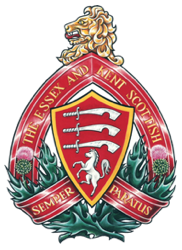Lieutenant-Colonel Doug McIntyre, DSO, MiD

A portrait of Doug McIntyre.
Major D.W. “Doug” McIntyre served with the 1st Battalion, The Kent Regiment beginning in 1940. He joined the Essex Scottish Regiment overseas during World War II after the Dieppe Raid in 1942.
In August 1944, he was tasked with leading a depleted Support Company of The Essex Scottish into Point 152 of the Falaise Gap following significant losses by the regiment at Falaise and Caen. They were to advance to make contact with the German enemy who were trying to avoid encirclement. The pace of movement was approximately three miles an hour without unanticipated enemy fire or road obstructions, making the company’s progress sluggish. McIntyre describes this advance as chaotic and seemingly disorganized, although they passed through Damblainville, Barou, and Ammeville without incident. It was in the village of Tortisambert that they finally encountered enemy machine gun and anti-tank fire from German infantry entrenched in an artificial roadblock. McIntyre said that the Scottish were the first to “draw enemy blood” in their pursuit to the Seine River, which the men considered an honour. They were able to overcome the German obstruction and achieve their objective through effective manoeuvre and assault. Their efforts meant that the rest of the brigade could pass through safely. As they progressed on their route, they received conflicting reports from civilians and captured German soldiers about the German retreat, making the information unreliable. As they moved through French villages, civilians threw flowers and offered them foods such as apples, bread, and home-brewed beer. According to McIntyre, this reception made their trip worthwhile. They stopped in Chappelle Yvon, where McIntyre stated the area might have been nice for a picnic had their circumstances not been so dire. The presence of German 88mm anti-tank guns and the exchange of small arms fire led to the deaths of two soldiers.
The area around Port du Gravier on the Seine River was heavily fortified by the German army. They were ordered to delay the Allied advance long enough for the remainder of their army to retreat across the Seine River. The terrain ended on stark cliffs on one side, making it an ideal location to stage an ambush. McIntyre stated that the setting was like something out of an old Hollywood western film. Support Company was ambushed, taking heavy casualties at the bottom of these cliffs. Their Jeeps and Bren Gun carriers were immediately abandoned and subsequently destroyed. The unit was trapped there for three days. During the battle, McIntyre brought wounded men from his company and others to safety of a nearby cave, where they could be treated. Later that year McIntyre also led the Support Company during their operations in the Forêt de la Londe in August 1944.
In April 1945, McIntyre led “A” Company to secure a bridge over a major canal in Groningen, Holland. This attack in Kangaroo armoured carriers captured the bridge and subsequently helped to liberate Groningen. McIntyre receive a Distinguished Service Order for his actions. McIntyre continued to be involved with the liberation of German-occupied territory, including Westende, Belgium, where they named a street “Essex-Scottish Laan” after the regiment in gratitude.
After the war, returned to the Kent Regiment. He was promoted to Lieutenant Colonel and appointed to commend the Kents from 1952 to 1954. McIntyre developed specialized training exercises, Exercises BEAVER and BEAVER II, focused on water-borne assaults and needed the use of Royal Canadian Air Force helicopters to complete the missions. Lieutenant-Colonel McIntyre continued to create training exercises for the Kents, including Exercise MUSCRAT. He also developed a trumpet band for the regiment and a ceremonial guard company, which fostered pride in the regiment and encouraged recruitment. At the time of the amalgamation of the Essex Scottish and Kent Regiment in 1954, McIntyre was one of the few that had served with both regiments. Cases such as McIntyre’s became examples by some used to justify the regiment’s name change to The Essex and Kent Scottish. McIntyre retired from command of the Kent Regiment in November 1954, shortly after the amalgamation on 1 October.
Story by Nicole Pillon, Canada Summer Jobs 2022 participant
with The Essex and Kent Scottish Regiment Association
Sources
- “Pursuit to the Seine: The Essex Scottish Regiment and the Foret De La Londe, August 1944” by Lt. Col. Doug W. McIntyre
- “Memories: A Photo Feature” by Lt. Col. Doug W. McIntyre
- Duty Nobly Done: The Official History of the Essex and Kent Scottish Regiment by Sandy Antal and Kevin R. Shackleton: Chapters 15
